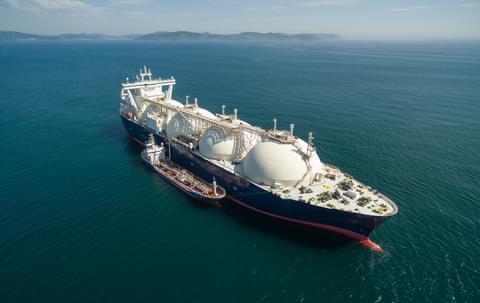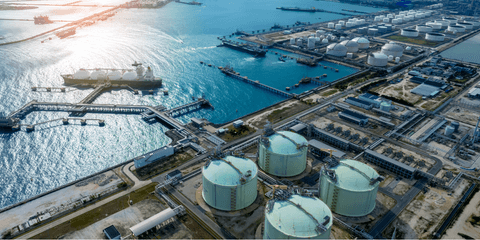
Liquefied natural gas (LNG) is natural gas that has been transformed into a liquid by cooling it to a very low temperature. This process reduces its volume significantly, making it easier and more practical to store and transport compared to its gaseous state. While natural gas serves as a conventional energy source for various purposes like heating, cooking, and transportation, its classification as a fossil fuel highlights the need to transition towards sustainable energy alternatives due to its finite nature and environmental impact.

The primary difference between liquified natural gas (LNG) and normal natural gas lies in their physical states and handling properties. LNG is natural gas that has been cooled to around -162 degrees celsius, causing it to condense into a liquid state. This process reduces the volume of natural gas significantly, making it more practical for storage and transportation purposes compared to its gaseous form.
LNG is much denser than normal natural gas, occupying about 1/600th of the volume when in liquid form. Specialised cryogenic tanks and ships are required to store and transport LNG safely due to its extremely low temperature.
In contrast, normal natural gas is predominantly used in its gaseous state for applications such as heating, cooking, and electricity generation. LNG can be converted back into its gaseous form through a process called regasification upon reaching its destination, allowing for versatile use across various industries and sectors.
This transformation and the need for specialised infrastructure differentiate LNG from normal natural gas, enabling efficient long-distance transportation and broader accessibility of natural gas resources.
Liquid natural gas (LNG) has a wide range of industrial applications, and is primarily used for its power as an energy supply for the following scenarios:
LNG is used as a fuel for power generation in various industries, including electricity generation plants and industrial facilities that require large amounts of energy.
LNG is increasingly being used as a fuel for heavy-duty vehicles, such as trucks, buses, and ships. It offers environmental benefits compared to traditional fuels like diesel, including lower emissions of pollutants and greenhouse gases.
The global demand for liquefied natural gas (LNG) is projected to increase significantly in the coming years, fueled by global energy transition initiatives and substantial industrial shifts from coal to gas, particularly in China. And that's why at Tower, we recognise the importance of this trend, especially within the shipping industry, including industrial marine and cruise sectors, where LNG-powered vessels are advancing. We work closely with customers in these sectors to provide tailored solutions including our range of marine FR coveralls.
LNG is used fuel for manufacturing diverse items such as electronic devices, fabrics, fertilisers, pharmaceutical products or plastics, among many others.
LNG can be used for heating purposes in industrial facilities, for domestic heating and cooling applications, such as in refrigeration and air conditioning systems.
In terms of storage, LNG is typically stored in specialised cryogenic tanks at very low temperatures (-162 degrees Celsius) to keep it in its liquid state. These storage tanks are commonly used at LNG import and export terminals, as well as at facilities where LNG is used for industrial or transportation purposes.

LNG (Liquid Natural Gas) itself is not inherently dangerous; however, risks arise when it is released into the open and turns into natural gas. Here are the main dangers associated with LNG.
In addition to these main dangers, other risks associated with LNG include burns from exposure to LNG or natural gas fires, as well as asphyxiation in the event of oxygen displacement by the release of natural gas vapours. Proper safety measures, emergency response procedures, and risk mitigation strategies are essential to minimise these dangers and ensure the safe handling and storage of LNG.
In the workplace, the responsibility for managing health and safety, including the handling of hazardous substances like LNG, is governed by legal frameworks and regulations in the UK. HSE is the lead agency for LNG safety.
The terminal operator has a duty to prepare and test emergency procedures for dealing with the consequences of a major accident. The Local Authority must prepare an emergency plan which details how an emergency relating to a possible major accident in its area will be dealt with. The primary responsibility for ensuring safety lies with the operator of the LNG site.
The HSE assesses safety reports submitted by operators before and during construction of Control of Major Accident Hazards (COMAH) sites. They conduct regular inspections during construction and throughout the site's operational life to ensure ongoing safety.
Given the nature of LNG sites, the HSE collaborates closely with other relevant agencies like the Maritime and Coastguard Agency and Hazardous Substances Authorities to coordinate responses as needed.
However here are the key stakeholders responsible for health and safety in the workplace:
Employers have the primary legal responsibility for ensuring the health, safety, and welfare of their employees and others who may be affected by their work activities. This includes implementing risk assessments, providing appropriate training and supervision, and maintaining a safe working environment.
Employees have a legal duty to cooperate with their employer on health and safety matters. They must follow workplace procedures, use safety equipment provided, and report any hazards or concerns to their employer.
Specific regulations and legal frameworks apply to the handling of hazardous substances like LNG in the workplace. For example, the Control of Substances Hazardous to Health (COSHH) Regulations require employers to assess and control risks associated with hazardous substances, including LNG, and to provide appropriate training and protective measures to employees.
When working with liquefied natural gas (LNG), it's crucial to prioritise safety by using appropriate Personal Protective Equipment (PPE). Here are recommended PPE solutions.
These PPE solutions are essential for safeguarding workers during LNG handling activities. Proper training in PPE usage and adherence to safety protocols are also vital for maintaining a safe work environment.
Remember to conduct regular inspections of PPE, replace damaged equipment promptly, and ensure all workers are properly trained in safety procedures when working with LNG. Safety is paramount when handling hazardous substances like LNG, and the use of appropriate PPE plays a critical role in risk mitigation.
Liquefied Natural Gas (LNG) is a promising future fuel due to its environmental benefits, versatility across various sectors, contribution to energy security by diversifying sources, global availability, and advancing technologies.
Leading exporting nations like Qatar, Australia, and the U.S. meet demand from top importers such as Japan, China, and South Korea, supporting a transition to cleaner energy sources and promoting global energy stability through economic viability and trade cooperation.
LNG can offer cost savings compared to traditional fuels like diesel or coal, especially in regions with abundant natural gas resources. It can be a cost-effective alternative for power generation, transportation, and industrial applications.
LNG produces fewer emissions of air pollutants and greenhouse gases compared to coal and oil. It helps reduce environmental impact and supports efforts to combat climate change.
LNG enhances energy security by diversifying fuel sources. It reduces dependency on imported oil and promotes stability in energy supply chains, contributing to reliable energy access.
LNG is versatile for transportation, allowing for efficient movement via ships, trucks, or pipelines. Its flexibility in storage and distribution supports effective energy logistics.
Many governments provide incentives and support for LNG adoption, including tax incentives, subsidies for infrastructure development, and regulatory support. These incentives encourage investment and use of LNG.
LNG can offer risk mitigation benefits, particularly in terms of energy supply resilience and stability. Its storage capabilities and diversified sourcing reduce risks associated with disruptions in traditional fuel supplies.
In summary, LNG offers cost savings, and environmental benefits through reduced emissions, enhances energy security and reliability, supports efficient transportation and logistics, attracts government incentives, and provides risk mitigation advantages for energy supply chains. These benefits position LNG as a valuable and strategic energy resource for various industries and applications.
At Tower, we understand that there can be no compromises when it comes to protection and safety at work. That's why working with a trusted supplier like Tower is paramount. We offer a comprehensive range of personal protective equipment (PPE) designed to meet stringent safety standards and enhance workplace safety across diverse industries.
Our meticulously designed products are tailored to specific work environments, ensuring optimal protection and comfort for workers. With our extensive expertise, we provide valuable advice on caring for your PPE and emphasise the importance of partnering with a reliable supplier like Tower.
We specialise in mitigating risks in some of the most hazardous workplaces worldwide. Our branded PPE apparel not only ensures safety but also reflects professionalism, enhancing your company's image.
Ensure all your PPE needs are met with Tower, an accredited, full-service supplier you can trust. Discover why choosing Tower for your PPE needs is the sensible choice.
For any enquiries about your PPE provisions or to learn more about our offerings, feel free to reach out to our dedicated team. We're here to assist you in prioritising safety and protection in your workplace.